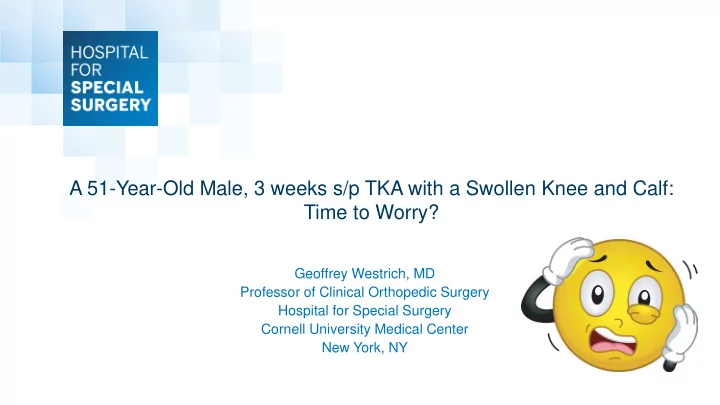

A 51-Year-Old Male, 3 weeks s/p TKA with a Swollen Knee and Calf: Time to Worry? Geoffrey Westrich, MD Professor of Clinical Orthopedic Surgery Hospital for Special Surgery Cornell University Medical Center New York, NY
A 51-Year-Old Male, 3 weeks s/p TKA with a Swollen Knee and Calf Important Questions to Ask Patient Is this new onset swelling? Were you doing well? How has this affected your ROM/gait? Any fever, chills, night sweats? Is your wound clean and dry? – Erythema? Ecchymosis? Worsening? Is there new onset pain in your calf? Any trauma or injury?
A 51-Year-Old Male, 3 weeks s/p TKA with a Swollen Knee and Calf Differential Diagnosis Deep Venous Thrombosis Hematoma / Hemarthrosis Infection Trauma – Ligament Injury – Muscle Injury – Medial Arthrotomy Rupture Normal Postoperative Finding
Deep Venous Thrombosis • Ask About Risks and Family History • h/o TED, family hx, hypercoagulable states, obesity, patient age, malignancy, venous insufficiency or lymphedema • Did patient take adequate prophylaxis? • PCD, aspirin or anticoagulant? • Physical Exam • Swelling, pain, warmth and redness • Homan’s Sign • Duplex U/S • Successfully identifies 95% of proximal DVT • When positive- no further testing is necessary • If negative- chance that DVT is so small- no treatment
DVT Treatment – Work with Internist Treatment Dosing for DVT • Lovenox 1 mg/kg Q 12 hours X 7 days • Coumadin INR 2.0 to 3.0 Initial dose: Xarelto 15 mg orally BID for first 21 days Maintenance dose: 20 mg orally QD for duration of treatment. Initial dose: Eliquis is 10 mg orally BID for 7 days Maintenance dose: 5 mg orally BID for duration of treatment
Hematoma/Hemarthrosis • Hematoma with NO drainage: • Etiology • Poor arthrotomy closure • Lateral release • Potent anticoagulation (Elevated INR?) • Aggressive physical therapy • Trauma • Treatment • Start with observation • Ice and elevate • PT on hold, No CPM • Cessation of anticoagulants (Check INR) • Antibiotics not indicated
ESR Hematoma/Hemarthrosis • Hematoma with drainage: Serosanguinous drainage: 1-10%. • Persistent drainage: Drainage from wound > 72 hrs • Persistent drainage can lead to infection! • Confirm that it is not infectious • • WBC, ESR, CRP CRP • Aspiration • Infection: >28K WBC, >89% polys (Bedair) • Hemarthrosis: Red, low WBC, Cx neg, Alpha Def. neg
Hematoma/Hemarthrosis: Treatment Evacuation of Hematoma In wound without drainage: If tension on skin, can ’ t do PT, increasing pain then consider evacuation In persistent draining wounds - evacuate Look for arterial bleeding (lateral geniculate?) – Remove polyethylene liner to check posteriorly “ Early return to surgery for evacuation of a postoperative hematoma after primary TKA ” Hansen & Clarke, JBJS 2008 – Incidence 0.24% – Subsequent major surgery: 12.3% – Risk of deep infection: 10.5% Avoid potent anticoagulation postoperatively –
Diagnosis of Infection Physical Laboratory History Aspiration Analysis Exam • Fever, chills, night • WBC • Wound Inspection: • Cell Count in sweats? • ESR > 50 mm/h • Erythema Infection: • CRP > 10 mg/l • Edema • >28K WBC • Constant Pain/Night • Usually nl • Drainage • >89% polys Pain 3 wks postop (Bedair et al) • Pain associated with • Plain Radiographs • Painful ROM/Ambulation • Alpha Defensin + decreased ROM • Gram Stain + • Culture + • Recent UTI or infections • Wound Drainage
Infection: Treatment • Irrigation and Debridement • Change polyethylene insert • “Polyethylene liner exchange seemed to prevent the recurrence of infections by removing microorganisms present between the metal tibial tray and the polyethylene liner ” (Kim 2015, CiOS) • Removal of the polyethylene tibial insert is very important in order to gain access to posterior aspect of the joint. Choi showed that not exchanging the polyethylene insert was an independent risk factor for failure (Qasim 2017, SICOT J) • < 3 weeks of symptoms (n=46): 69% had successful infection eradication regardless of bacterial strain. The success rate for bacteria other than MRSA and Pseudomonas was 85% (Dugue 2017, JOA). • Staph infections add Rifampin: 62% w/o and 77% w/ Rifampin (Holmberg 2015) • Washout with 3% Hydrogen Peroxide and 1% Betadine • George et al used 1% povidone iodine and a 3% hydrogen peroxide solution • No recurrences of infection 28 knees @ 6.5 years (Lu and Hansen JB&JI 2017). • Sukeik: 77% success rate with no recurrence or loosening at latest follow up (CORR 2012)
Differential Diagnosis: Trauma • Ask if h/o trauma or overdoing PT • Trauma • Ligament Injury - MCL • Muscle Injury – Gastroc / Soleus • Medial Arthrotomy Rupture • Focused Physical Exam • Palpate to feel for defect • Ultrasound/MRI
Normal – Diagnosis of Exclusion Then you can relax and go fishing Rest Ice Elevate Edema Control Follow Up
THANK YOU! Hospital for Special Surgery New York, NY
Recommend
More recommend